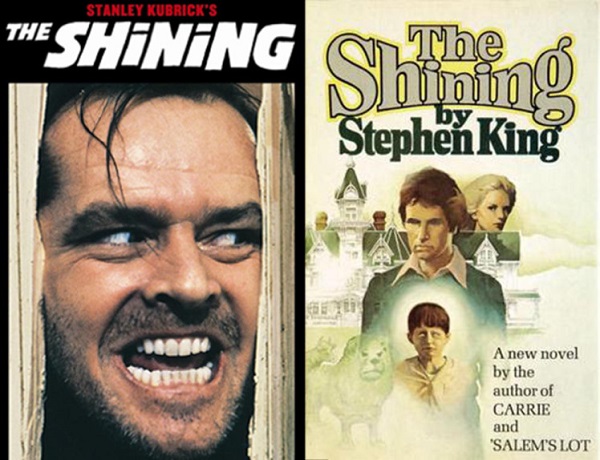The Shining: Debrief of the Book vs Movie

Source: AmReading
September 8, 2022
One of the biggest risks the film industry can take, is creating a movie adaption from a popular novel or series. Especially with a classic like “The Shining” by Stephen King, director Stanley Kubrick was willing to take the risk. The film obviously did phenomenal, which leads to one of the most heated debates about King’s masterful story: the Shining book or movie? While both are outstanding flowers rooted in the same garden, different seeds are planted.
Besides the small changes such as room 217 becoming room 237 as the haunted room in Kubrick’s adaptation, the two iconic versions have many clear differences. While following the main plot of the Torrance family living in the ‘Outlook Hotel’ for winter, the time shared at the hotel leads to different experiences. For example, the iconic twins in the ‘Shining’ movie were never mentioned in the book. They were added for a dramatic effect.
An important main character in both the novel and film is Dick Hallorann. The drastic difference between the two changed the pace of the storyline. In the film, Hallorann is killed by Jack. In the novel, he makes it to the end, helps save Wendy and Danny and is even a part of the flash forward chapter. It is a big deal that Jack kills Hallorann in the film, because in the novel he never actually kills anyone. This enhances the evil that lies within Jack and creates an even more sick and twisted plot. It enhances his death as being even more deserving since he is now a murderer.
Another major plot point that did not exist within the novel, is Wendy seeing what Jack is working on. During the film, Wendy comes across what Jack has been working on throughout the whole stay. This never happens in the novel. The reason this struck a drastic difference, was it led to Jack going on a rampage. The moment Jack sees that Wendy saw his work, he snaps. He starts to follow her and attempts to hurt her. It is Jack Nickleson’s way of playing his character as someone who is hiding something that must not be seen. This finally leads to another major plot point difference.
Danny locks Jack in a cellar in the novel, not Wendy. In the novel, Wendy is more put together than on the screen. In my personal belief, I believe Kubrick changed who shut Jack in the cellar to redeem Wendy and her confidence. In the film adaptation, Wendy cries a lot and is a train wreck. She is not at all ready for battle, compared to the novel. This difference in the storyline was a way to redeem Wendy, and show off some of her novel-like characteristics. In the film adaptation, Danny is not even around at the moment Jack is locked in the cellar. Danny is hiding. My personal belief was Kubrick wanted Danny to act more his age, and for Wendy to show off the confidence she is filled with in the novel.
The “Shining” novel is known as one of the greatest novels to exist. The film is known as one of the most iconic films in cinema history. Such cinema appreciators, like myself, love to see and feel the beauty of cinema. Analyzing the set designs, and the visuals brings great joy. The Kubrick version brings the magic of the “Shining” to life, and fulfills the satisfaction for true horror lovers. Once being able to see the behind the scenes of the movie, you’ll see the beauty of the actors and crew, and how they captivate art. Jack Nicholson and Shelley Duvall’s performance intensified the piece, and brought on the true horror the “Shining” enthralls. The way they perform mesmerized the audience, and shines the beautiful, twisted story from King’s twisted mind.
Stephen King and Stanley Kubrick are both absolute masterminds. They know how to create art, and not only art, but art that lasts. They both will forever go down in history as creative geniuses. The novel and the film are forever iconic and paved the way for future horror generations. Given the differences, it is hard to decide which is the ultimate “Shining”. They are beautiful and unique in their own ways, and will forever be appreciated and acknowledged.































